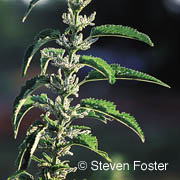Stinging nettle
Nettle; Urtica dioica; Urtica urens; Urtica radix
Stinging nettle (Urtica dioica and the closely related Urtica urens) has a long medicinal history. In medieval Europe, it was used as a diuretic (to rid the body of excess water) and to treat joint pain.
Stinging nettle has fine hairs on the leaves and stems that contain irritating chemicals, which are released when the plant comes in contact with the skin. The hairs, or spines, of the stinging nettle are normally very painful to the touch. When they come into contact with a painful area of the body, however, they can actually decrease the original pain. Scientists think nettle does this by reducing levels of inflammatory chemicals in the body, and by interfering with the way the body transmits pain signals.
General UsesStinging nettle has been used for hundreds of years to treat painful muscles and joints, eczema, arthritis, gout, and anemia. Today, many people use it to treat urinary problems during the early stages of an enlarged prostate (called benign prostatic hyperplasia or BPH). It is also used for urinary tract infections, hay fever (allergic rhinitis), or in compresses or creams for treating joint pain, sprains and strains, tendonitis, and insect bites.
Benign Prostatic Hyperplasia (BPH)Stinging nettle root is used widely in Europe to treat BPH. Studies in people suggest that stinging nettle, in combination with other herbs (especially saw palmetto), may be effective at relieving symptoms such as reduced urinary flow, incomplete emptying of the bladder, post urination dripping, and the constant urge to urinate. These symptoms are caused by the enlarged prostate gland pressing on the urethra (the tube that empties urine from the bladder). Some studies suggest that stinging nettle is comparable to finasteride (a medication commonly prescribed for BPH) in slowing the growth of certain prostate cells. However, unlike finasteride, the herb does not decrease prostate size. Scientists aren't sure why nettle root reduces symptoms. It may be because it contains chemicals that affect hormones (including testosterone and estrogen), or because it acts directly on prostate cells. It is important to work with a doctor to treat BPH, and to make sure you have a proper diagnosis to rule out prostate cancer.
OsteoarthritisThe leaves and stems of nettle have been used historically to treat arthritis and relieve sore muscles. While studies have been small, they suggest that some people find relief from joint pain by applying nettle leaf topically to the painful area. Other studies show that taking an oral extract of stinging nettle, along with nonsteroidal anti-inflammatory drugs (NSAIDs), helps people reduce their NSAID dose.
Hay feverOne preliminary human study suggested that nettle capsules helped reduce sneezing and itching in people with hay fever. In another study, 57% of patients rated nettles as effective in relieving allergies, and 48% said that nettles were more effective than allergy medications they had used previously. Researchers think that may be due to nettle's ability to reduce the amount of histamine the body produces in response to an allergen. More studies are needed to confirm nettle's antihistamine properties. Some doctors recommend taking a freeze-dried preparation of stinging nettle well before hay fever season starts.
OtherPreliminary animal studies indicate that nettle may lower blood sugar and blood pressure. However, more research is needed to determine whether this is also true in humans.
Plant Description
Stinging nettle is the name given to common nettle, garden nettle, and hybrids of these plants. Originally from the colder regions of northern Europe and Asia, this herbaceous shrub grows all over the world today. Stinging nettle grows well in nitrogen-rich soil, blooms between June and September, and usually reaches 2 to 4 feet high.
Stems are upright and rigid. Leaves are heart shaped, finely toothed, and tapered at the ends, and flowers are yellow or pink. The entire plant is covered with tiny stiff hairs, mostly on the underside of the leaves and stem, that release stinging chemicals when touched.
What's It Made Of?
Stinging nettle products are usually made from the leaves and stems, and sometimes the roots. Root preparations are used to relieve symptoms of BPH.
Available Forms
Stinging nettle is available as dried leaf, freeze-dried leaf, extract, capsules, tablets, and as root tincture (a solution of the herb in alcohol), juice, or tea. It also comes in the form of an ointment or cream that can be applied to the skin. The root appears to have different pharmacological effects than the leaves.
How to Take It
PediatricAlthough stinging nettle is available in many combination formulas to treat colds, asthma, and allergies in children, a specific safe and effective dose for children has not yet been established. Talk to your doctor before giving stinging nettle to a child, so the doctor can determine the proper dose.
AdultStinging nettle is used in many forms, including as teas, tinctures, fluid extracts, and creams.
Precautions
The use of herbs is a time-honored approach to strengthening the body and treating disease. However, herbs can trigger side effects, and can interact with other herbs, supplements, or medications. For these reasons, you should take herbs with care, under the supervision of a health care provider.
Stinging nettle is generally considered safe when used as directed. Occasional side effects include mild stomach upset, fluid retention, sweating, diarrhea, and hives or rash (mainly from topical use). It is important to be careful when handling the nettle plant because touching it can cause an allergic rash. Stinging nettle should never be applied to an open wound.
Because nettle can alter the menstrual cycle and may contribute to miscarriage, pregnant women should not use nettle.
DO NOT self treat with nettle for BPH. See your doctor to receive a diagnosis and to rule out prostate cancer.
There is some evidence that stinging nettle may raise blood sugar and interfere with diabetes management. There is also evidence that it can lower blood sugar. Patients with diabetes should monitor their blood sugar closely when using stinging nettle.
Stinging nettle can have a diuretic effect. If you have kidney or bladder issues, speak with your provider.
Possible Interactions
Antiplatelet and anticoagulant drugs (blood thinners)Stinging nettle may affect the blood's ability to clot, and could interfere with blood-thinning drugs, including:
- Warfarin (Coumadin)
- Clopidogrel (Plavix)
- Aspirin
Stinging nettle may lower blood pressure, so it could strengthen the effects of these drugs:
- ACE inhibitors: Captopril (Capoten), Elaropril (Vasotec), lisinopril (Zestril), fosinopril (Monopril)
- Beta-blockers: Atenolol (Tenormin), metoprolol (Lopressor, Toprol XL), propranolol (Induran)
- Calcium channel blockers: Nifedipine (Procardia), amlodipine (Norvasc), verapamil (Calan, Isoptin)
Because stinging nettle can act as a diuretic, it can increase the effects of these drugs, raising the risk of dehydration:
- Furosemide (Lasix)
- Hydrocholorothiazide
Stinging nettle may lower blood sugar, so it could strengthen the effects of these drugs, raising the risk of hypoglycemia (low blood sugar).
LithiumStinging nettle may have a diuretic effect and may reduce the body's ability to remove this drug.
Nonsteroidal anti-inflammatory drugs (NSAIDs)In a scientific study of patients with acute arthritis, stewed stinging nettle leaves enhanced the anti-inflammatory effect of diclofenac, an NSAID. Although this effect can reduce pain, talk to your doctor before taking or using stinging nettle if you also take NSAIDs.
Supporting Research
Blumenthal M, Goldberg A, Brinckmann J. Herbal Medicine: Expanded Commission E Monographs. Newton, MA: Integrative Medicine Communications; 2000:367-375.
Bodemer AA. Urticaria. In: Rakel D, ed. Integrative Medicine. 3rd ed. Philadelphia, PA: Elsevier Saunders; 2012:chap 70.
Bone K, Mill S, eds. Principles and Practices of Phytotherapy, Modern Herbal Medicine. London: Churchill Livingstone; 2000.
Chrubasik JE, Roufogalis BD, Wagner H, Chrubasik S. A comprehensive review on the stinging nettle effect and efficacy profiles. Part II: urticae radix. Phytomedicine. 2007;14:568-579.
Ernst E, Chrubasik S. Phyto - anti-inflammatories. A systematic review of randomized, placebo-controlled, double-blind trials. Rheum Dis Clin North Am. 2000;26:13-27.
Helms S, Miller A. Natural treatment of chronic rhinosinusitis. Altern Med Rev. 2006;11:196-207.
Johnson TA, Sohn J, Inman WD, Bjeldanes LF, Rayburn K. Lipophilic stinging nettle extracts possess potent antiinflammatory activity, are not cytotoxic and may be superior to traditional tinctures for treating inflammatory disorders. Phytomedicine. 2013; 20:143-147.
Koch E. Extracts from fruits of saw palmetto (Sabal serrulata) and roots of stinging nettle (Urtica dioica): viable alternatives in the medical treatment of benign prostatic hyperplasia and associated lower urinary tract symptoms. Planta Med. 2001;67:489-500.
Konrad L, Muller HH, Lenz C, Laubinger H, Aumuller G, Lichius JJ. Antiproliferative effect on human prostate cancer cells by a stinging nettle root (Urtica dioica) extract. Planta Med. 2000;66:44-47.
Lopatkin NA, Sivkov AV, Medvedev AA, et al. Combined extract of Sabal palm and nettle in the treatment of patients with lower urinary tract symptoms in double blind, placebo-controlled trial. Urologiia. 2006;(2):12, 14-91.
Nahata A. Ameliorative effects of stinging nettle (Urtica dioica) on testosterone-induced prostatic hyperplasia in rats. Andrologia. 2012; 44:396-409.
Pittler MH. Complementary therapies for treating benign prostatic hyperplasia. FACT. 2000;5:255-257.
Popa G, Hagele-Kaddour H, Walther C. Efficacy of a combined Sabal-urtica preparation in the symptomatic treatment of benign prostatic hyperplasia. Results of a placebo-controlled double-blind study. MMW Fortschr Med. 2005;147 Suppl 3:103-108.
Randall C, Randall H, Dobbs F, Hutton C, Sanders H. Randomized controlled trial of nettle sting for treatment of base-of-thumb pain. J R Soc Med. 2000;93:305-309.
Safarinejad MR. Urtica dioica for treatment of benign prostatic hyperplasia: a prospective, randomized, double-blind, placebo-controlled, crossover study. J Herb Pharmacother. 2005;5:1-11.
Schneider T, Rubben H. Stinging nettle root extract (Bazoton-uno) in long term treatment of benign prostatic syndrome (BPS). Results of a randomized, double-blind, placebo controlled multicenter study after 12 months. Urologe A. 2004;43:302-306.
Schulze-Tanzil G, de SP, Behnke B, Klingelhoefer S, Scheid A, Shakibaei M. Effects of the antirheumatic remedy hox alpha - a new stinging nettle leaf extract - on matrix metalloproteinases in human chondrocytes in vitro. Histol Histopathol. 2002;17:477-485.
Tarhan O, Alacacioglu A, Somali I, Sipahi H, Zencir M, Oztop I, Dirioz M, Yilmaz U. Complementary-alternative medicine among cancer patients in the western region of Turkey. J BUON. 2009;14:265-269.
Wilt TJ, Ishani A, Rutks I, MacDonald R. Phytotherapy for benign prostatic hyperplasia. Public Health Nutr. 2000;3:459-472.

Review Date: 1/1/2017
Reviewed By: Steven D. Ehrlich, NMD, Solutions Acupuncture, a private practice specializing in complementary and alternative medicine, Phoenix, AZ. Review provided by VeriMed Healthcare Network. Also reviewed by the A.D.A.M. Editorial team.

